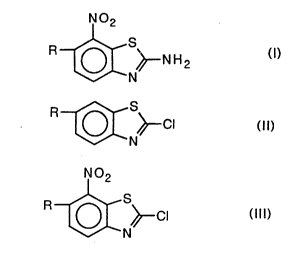Note: Descriptions are shown in the official language in which they were submitted.
2121X~6
PROCEDE DE PREPARATION D'AMINO-2 NITRO-7 BENZOTHIAZOLES
La pr~sente invention concerne un procédé de préparation d'amino-2
nitro-7 benzothiazoles de formule:
N02
R~CN~N H2 (1)
5 dans laquelle R représente un radical polyfluoroalcoxy.
La nitration directe d'amino-2 benzothiazoles substitués en position
-6 conduit à un mélange d'amrno-2 nitro-4 et nitro-5 benzothiazoles
(EP 374041).
Il est également connu de préparer les nitro-4, -~, -6 ou -7 amino-2
10 benzothiazoles par réaction de dinitrochlorobenzènes ou dinitrophényl
thiocyanates avec la thiourée ou le thiocyanate d'ammonium (brevet US
4808723, R. HAMPRECH, Chem. Abstr., 101, 211131 et J. SCHULZE et
coll., Z. Chem., 20, 436 (1980)); par réaction de nitroph~nylthiourées avec
S2G12 ou un complexe plomb(lV)-phosphate ~S. CLAUDE et coll., Helv.
15 Chem. Acta, 64, 1545 (1981); S.A. Von MAHMOUD et coll., Prakt. Chemie,
316, 154 (1974). C~pendant, ces cyclisations ne sont pas toujours
régiosélectives.
Il a maintenant été trouvé et c'est ce qui fait l'objet de la présente
demande, un procédé permettant d'obtenir industriellement les composés de
20 formule (I) avec de bons rendements.
Ce procédé consiste à
a) nitrer un dérivé de formule:
WO 93/12099 PCI'/FR92/01165
2121~06 ` ~
R~SN~CI (Il)
dans laquelle R a les mêmes significations que dans la torrnule (I)j et
b) faire réagir le composé de formule:
N02
R~S~CI (111)
5 dans laquelle R a les mêmes significations que dans la formule (I), ainsi
obtenu avec l'hydroxyde d'ammonium.
Il est particuliarement avantageux d'effectuer la nitration de l'étape a)
au moyen d'un mélange acide nitrique-acide suffurique.
Généralement, on utilise un mélange acide nitrique-acide sulfurique
10 comprenant 1 partie en volume d'acide nitrique concentré et 1 à 5 parties en
poids d'acide suHurique concentré. Il est prétérab.e d'utiliser un mélange
comprenant 1 partie d'acide n~rique concentré et 3,7 parties d'acide
sul~urique concentré.
La quantité du mélange acide nitrique-acide sul~urique est comprise
15 entre 1 et 10 parties en volume pour une partie en poids du dérivé de ~ormule (Il) mis en oeuvre.
La température réactionnelle sst de préférence comprise entre 0C et
20C.
L'étape b) s'effectue généralement au sein d'un solvant organique
20 inerte tel qu'un alcool (m~thanol, éthanol par exemple), dans un réacteur
fermé.
Il est ~articulièrement avantageux d'opérer à une température
comprise entre 1 0C et 1 50C.
2121806
On utilise généralement 5 à 20 parties en poids d'hydroxyde
d'ammonium pour une partis en poids du dérivé de ~ormule (Ill) mis en
oeuvre.
Les dérivés de formule (Il) peuvent être obtenus par application ou
5 adaptation de la méthode décrite dans le brevet EP 43013.
Les composés de formule (I) peuvent être s~parés du mélange
réactionnel selon les techniques habituelles de séparation (extraction,
chromatographie, cristallisation...).
Les composés de formule (I) sont utiles comme médicaments ou
10 intermédiaires pour préparer des médicaments (EP 282971 et 374941) ou
comme intermédiaires pour colorants (brevets US 2149051, 4363913, GB
21631 74) .
L'exemple suivant montre comment l'invention peut être mise en
oeuvre.
15 EXEMPLE 1
a~ Préparation du chloro-2 nitro-7 trifluorométhoxy-6 benzothiazole
10 9 de chloro-2 trHluorométhoxy-6 benzothiazole sont ajoutés, goutte à
goutte, en une heure, à un mélange refroidi à 10C d'acide sulfurique
concentr~ (50 cm3) et d'acide nitrique concentré (25 cm3j. Le mélange est
20 ensuite chauffé une heure à BOC. Après refroidissement, le mélange est
versé dans un mélange eau-glace (1/1 en poids) et extrait avec 3 fois
100 cm3 de chloroforme. Les phases organiques sont séchées sur sulfate de
magn~sium et concentrées sous vide (2,7 kPa). Le résidu est purifié par
flash-chromatographie avec un mélange chloro~orme-cyclohexane ~4/6 en
25 volumes) comme éluant. On obtient ainsi 6,4 9 de chloro-2 nitro-7
trifluorométhoxy-6 benzothiazole fondant à 64C.
b) Préparation de l'amino-2 nitro-7 trifluorométhoxy-6 benzothiazole
Un mélange de 0,4 g de chloro-2 nitro-7 trifluorornéthoxy-6 benzothia701e et
- 10 cm3 d'une solution aqueuse à 33% d'hydroxyde d'ammonium dans
^,. . ...
FEU~I LE DE F~E5'~,~?~ E~Y1ENT
WO 93/12099 ~! 1 2 1 ~ ~) fi Pcr/FRs2/01 165
30 cm3 d'éthanol est chauffé à 110C dans un autoclave pendant 5 heures.
Le mélange est re~roidi et le solvant est évaporé sous pression réduite (2,7
kPa). Après purification par tlash-chromatographie sur silice avec un
mélange cyclohexane-acétate d'éthyle (4/6 en volumes) comme éluant, on
S obtient 0,22 9 d'amino-2 nitro-7 tr-dluorométhoxy-6 benzothiazole fondant à
180C.
c) Préparation des intermédiaires
49,4 9 d'hydrazino-2 trifluorométhoxy-6 benzothiazole sont ajoutés en une
heure à 97,9 g de chlorure de thionyle chauffé à 50C. Le mélange est
10 ensuite chauffé une heure à cette même température puis refroidi à 0C.
Après addition de 200 9 d'un mélan~e eau-glace (1/1 en poids), le précipité
est tiltré et lavé avec 2 fois 50 cm3 d'eau. On obtient ainsi 54,5 g de chloro-2trifluorométhoxy-6 benzothiazole fondant à 50C.
A une suspension de 93,6 9 d'amino-2 trdluorométhoxy-6 benzothiazole dans
15 420 cm3 d'éthylène glycol sous courant d'æote, on ajoute 48 g d'hydrazine
hydratée et 42 ~ de dichlorhydrate d'hydrazine. Le mélange est chauffé 2
heures à 140C. Apr~s re~roidissement, le pr~cipité est filtré et trituré avec un
mélange eau-éther diéthylique (1/1 en volumes). On obtient ainsi 89,9 9
d'hydrazino-2 trifluorométhoxy-6 benzothiazole ~ondant à 208C.
20 L'amino-2 trdluorométhoxy-6 benzothiazole peut être préparé selon la
méthode décrite par L.M. YAGUPOLSKII et coll., Zh. Obshch. Khim., 33 (7),
2301 (1963).
